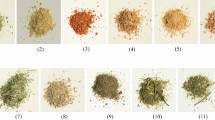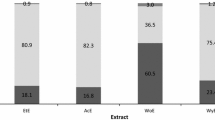Abstract
The beneficial effects of ∈-3 fatty acids on human health have been well documented. Fish and fish oils are the richest sources of ∈-3 fatty acids. However, due to their high degree of unsaturation, they are highly susceptible to lipid peroxidation. Regular consumption of peroxidised oils may represent a risk factor for the induction and development of atherosclerosis. In view of the above reports, it was considered necessary to study the effects of tumeric on fish lipid peroxidation during standard cooking practices and on time-dependent changes in the peroxidation of fish homogenate. The antioxidant effect of α-tocopherol was also studied to confirm the relevance of the study. The results suggest that turmeric may be considered as a safe, cheap and readily usable antioxidant for food preparations.
Similar content being viewed by others
Reference
Esterbauer, H. (1993) Cytotoxicity and genotoxicity of lipid oxidation products. Am. J. clin. Nutr. 57, 779–786.
DiMascio, P., Murphy, M.E. and Sies, H. (1991) Antioxidant defense system: The Role of carotenoids, tocopherol and thiols. Am. J. Clin. Nutr. 53, 194–200.
Kromhout, D., Bosschieter, E.B. and Coulander, C. (1985) The inverse relation between fish consumption and 20 year mortality from coronary heart disease. N. Engl. J. Med. 312, 1205–1209.
Shekelle, R.B., Missel, L. and Oglesby, P. (1985) Fish Consumption and mortality from cardiovascular disease. N. Engl. J. Med. 313, 820–22.
Pauline, M., Herald, J. and Kinsella, E. (1986) Fish oil consumption and decreased risk of cardiovascular diseases. A comparision of findings from animals and human feeding trials. Am. J. Clin Nutr. 43, 566–98.
Barcell, V., Glass, G. and Pollak, V.E., (1985) Enhancing effect of dietary supplementation with ω-3 fatty acid on plasma fibrinolysis in normal subjects. Thromb. Res. 39, 307–12.
Gordon, M., Gertude, H., Charles, J., Glueck, J.S., Janet, V. et al (1991) Blood pressure lowering effect on elderly subjects with ω-3 and ω-6 fatty acids. Am. J. Clin. Nutr. 53, 562–72.
Nair, P.G.V. (1996) Role of fish oils in control of heart disease. Advances and Priorities in fisheries technology. 350–352.
Sinclair, A.J. (1990) Free radicals and antioxidant system in Health and Diseases. Br. J. Hosp. Med. 43, 334–344.
Hunter, M.I.S. and Mohammed, J.B. (1986) Plasma antioxidants and lipid peroxidation products in Duchenne muscular dystrophy. Clin. Chim. Acta. 155, 123–132.
Haywood, R. M., Claxson, A.W.D., Hawkes, G. E., Richardson, D. A., Naughton, D. P., Coumbarides, G., Lynch, E. J and Grootveld, M. C. (1985) Detection of aldehydes and their conjugated hydroperoxydiene precursors in thermally stressed culinary oils and fats: Investigations using high resolution proton NMR Spectroscopy. FEBS Letter 355, 81–90.
Grootveld, M., Atherton, M.D., Sheerin, A.N., Hawkes, J., Blake, D. R., Richens, T. E., Silwood, C. J. L., Lynch. E and Claxson, A.W.D. (1998) In vivo absorption, metabolism and urinary excretion of α,β- unsaturated aldehydes in experimental animals. J. Clin. Invest. 102, 1216–1218.
Kunchandy, E and Rao, M.N.A (1990) Oxygen radical scavenging activity of curcumin. Int. J. Pharma. 58, 237–240.
Sharma, O.P. (1976) Antioxidant activity of curcumin and related compounds. Biochem. Pharmacol. 25, 811–812.
Ammon, H.P.T. and Wahl, M.A. (1990) Pharmacology of curcuma Longa. Planta. Medica. 57, 1–7.
Soudamini, K. K., Unnikrishnan, M.C., Soni, K.B. and Kuttan, R (1992) Inhibition of lipid peroxidation and cholesterol levels in human volunteers. Indian. J. Physio. Pharmacol. 36, 273–275.
Sreejayan, M. N. and Rao, M. N. A. (1994) Curcumnoids as potent inhibitors of lipid peroxidation. J. Pharm. Pharmacol. 46 (12), 1013–1016.
Srinivas, L.V.K., Shalini and Shylaja, M. (1992) Turmerin water soluble antioxidant peptide from turmeric. Arch. Biochem. Biophys. 292, 617–623.
Luotola, M.T. and Luotola, J.E.I. (1985) Effect of a- tocopherol on the peroxidation of cod liver oil. Life chemistry Reports 3, 159–163.
Dillard, C.J, Kunert, K.J and Tappel, A.L. (1982) Arch. Biochem. Biophys. 216, 204–206.
Gold, L.S., Shone, T.H., Stern, B.R., Manley, N.B and Ames B.N (1992) Science 258, 261–265.
Bannerjee, S., Khokher, S., Richard, K. and Apenten, O. (2001) Characterisation of lipoxygenase from mackerel muscle. Journal of food Chem. 26, 17–20.
Yagi, K (1987) Lipid Peroxidation and human disease. Chem. Phys. Lipids. 45, 337–351.
Seeman, P. (1990) Membrane action of anaesthetic and tranquilizers. Pharmacol. Rev. 24 (4), 589–595.
Tonnesen, H. H., Smistaad. G., Agren, T. and Karlsen, J. (1993) Studies on curcumin and curcuminoids XXIII: Effect of Curcumin on liposomal lipid peroxidation. Int. J. Pharm. 90, 221–228.
Reddy, A.C. and Lokesh, B.R. (1992) Studies on spice principles as antioxidants in the inhibition of lipid peroxidation of rat liver microsomes. Mol. Cell Biochem. 3, 117–124.
Reddy A, C. and Lokesh, B. R. (1994) Effect of dietary turmeric on iron-induced lipid peroxidation in rat liver. Food Chem. Toxicol. 32, 279–283.
Sreejayan Rao, M.N.A. (1993) Curcumin as inhibitor of iron-dependant lipid peroxidation. Int. J. Pharm. 100, 93–97.
Roberfroid, M.B., Viche, H.G and Remede, J. (1987) Free Radicals in Drug Research. In: Testa B (ed) adv. Drug Research Res. Vol 16. Academic Press London 2–43.
Bareclay, L.R.C., Vinquist, M.R., Mukai, K., Holi, S. and Morimoto H. (1993) Chain breaking phenolic antioxidant: Steric and electronic effects in polyalkyl chromanols tocopherol analogs. J. Org. Chem. 58, 7416–7420.
Priyadarshini, K. (1997) Free radical reactions of curcumin in membrane models. Free Radical Biol. Med. 23 (6), 838–843.
Author information
Authors and Affiliations
Rights and permissions
About this article
Cite this article
D'Souza, H.P., Prabhu, H.R. In vitro inhibition of lipid peroxidation in fish by turmeric (Curcuma longa). Indian J Clin Biochem 21, 138–141 (2006). https://doi.org/10.1007/BF02912929
Issue Date:
DOI: https://doi.org/10.1007/BF02912929




